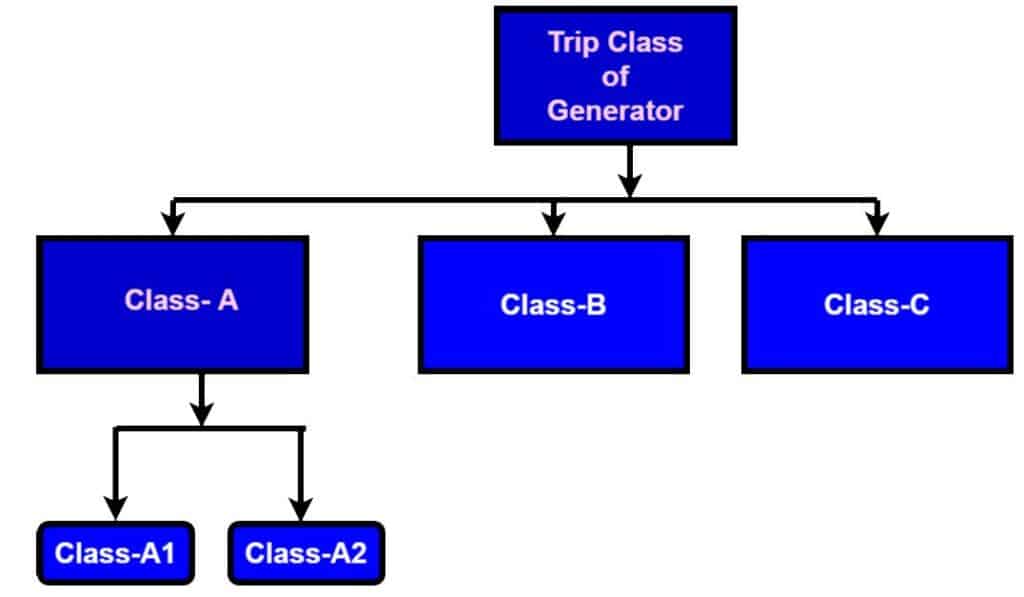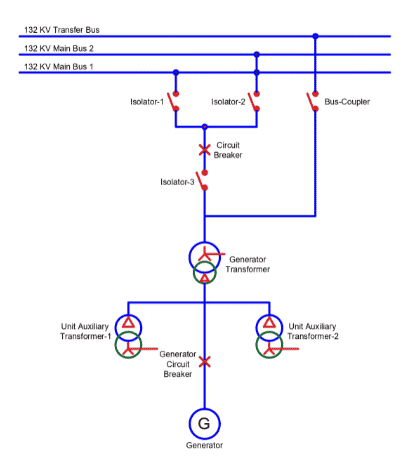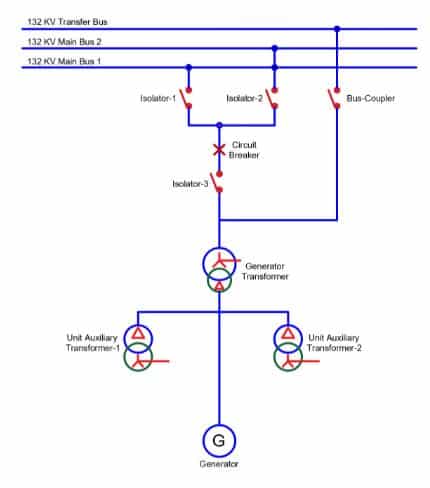Class-A, Class-B, and Class-C Tripping Classification of Generator are done according to types of the fault in the generator and its associated circuits. In this post, we will discuss the trip classes of generators in detail.
Basis of Tripping Classification
In the case of a fault in the electrical network, the generator needs to isolate from the supply system as well as from the turbine side to protect the generator. There are various protection schemes for the generator in use. We can classify the generator tripping classes on the basis of the nature of the fault.
Some faults, such as differential protection and stator earth fault, need to clear by tripping of generator breaker immediately. On the other hand, some faults do not need immediate action for generator breaker tripping. Thus, depending on the type of fault, the generator breaker tripping is accomplished automatically to safeguard the generator.
There are three classes of generator tripping. They are;
- Class-A
- Class-B
- Class-C
Now, we will have a discussion on each tripping class of the generator.

Class-A
The stator earth fault and the differential fault in a generator are the faults that show problems in the generator winding. If the generator remains connected to the grid, in this case, severe damage happens to the generator as well as to the electrical system. In such a case, the generator breaker needs to be isolated immediately. In such a situation, the protection scheme is called Class-A tripping of the generator. There are two ways of connecting the generator circuit breaker to the Grid supply.
The single line diagram synchronization scheme where the generator circuit breaker synchronizes. ( Synchronization with GCB Scheme)

The single line diagram synchronization scheme where the Grid circuit breaker synchronizes. ( Synchronization without GCB Scheme)

Class-A Trip
The class-A tripping can be further bifurcated into two categories.
- Class-A1
- Class-A2
Class-A1 Trip
Class-A1 comprises the faults that need immediate isolation of the generator. The list of the faults is as follows.
1. Generator Differential Protection(87G)
This protection operates when there is a fault in the stator of the generator winding. The relay sense and measure the incoming and outgoing current in the stator winding and shows the fault if there is a difference between the incoming and outgoing current in the winding. This difference between currents happens only when there is some fault in the winding.
2. Generator Over Voltage Protection(59)
Overvoltage in a generator occurs due to increased grid synchronized voltage, sudden load throw-off, lightning strike, transients, AVR malfunctioning, and turbine over speed. The overvoltage may cause insulation failure of the generator’s winding, and to protect the generator the protection relay must trip the generator breaker.
Overvoltage occurs due to sudden load through off, elevated grid synchronized voltage, AVR malfunctioning, power transformer taps changer failure, a lightning strike on the transmission line, turbine over speed, etc.
3. 100% Stator Earth Fault Protection(64G2)
The neutral grounding resistor (NGR) installed between the neutral point of the generator and the ground provides the earth fault protection for 95% of the stator winding. The balance 5% stator winding remains unprotected in this protection scheme. A different protection scheme is used to protect the balance 5 % winding to achieve 100 % stator earth fault protection.
4. Dead Machine Protection
The generator stator breaker must not be energized in standstill condition. This causes a generator to function as a motor. Consequently, it may cause damage to the generator. The dead machine protection ensures no energization of the generator in its standstill state.
Dead Machine Protection in a Generator is provided to ensure that Generator is not energized accidentally in standstill condition. or when the Generator is on Turning Gear.
5. 95% Stator Earth Fault Protection (64G1)
The neural point of the generator is connected to one end of the neutral ground resistor(NGR) and the other end of NGR is connected to the ground. This scheme is called resistance earthing. This scheme is used for generators to detect the fault in 95% of the stator winding. The protection relay trips the generator breaker in the event of an earth fault.
6. Starting Over Current Protection
The overcurrent protection ensures the tripping of the generator breaker in the case the current is above the full load current (FLC) of the generator.
On actuation of Class-A1 protection, the tripping of the following happen.
- Tripping the generator circuit breaker
- Tripping the generator’s field circuit breaker
- Turbine Tripping
Class-A2 Trip
Faults in the generator transformer(GT), isolated phase bus duct(IPBT), and unit transformer(UT) may cause damage to the generator and its associated circuits if the equipment does not isolate from the grid supply. All these faults are grouped in the class-A2 trip.
The following protection relays of the generator, grid transformer, and unit transformer provide the class A-2 trip.
- Over fluxing Protection of Generator
- Back up Impedance Protection of Generator
- Differential Protection of GT
- Buchholz Relay of GT
- PRD of GT
- Trip from OTI & WTI of GT
- Fire protection of GT
- Differential Protection of UT
- Buchcholz Relay & PRD of Main Tank of UT
- Trip from OTI & WTI of UT
- Fire protection of UT
In the event of initiation of the above-mentioned protection the following equipment is isolated from the supply system.
- Tripping of Generator Circuit Breaker
- Tripping of Field Circuit Breaker
- Tripping of Generator Transformer Circuit Breakers
- Tripping of Unit Transformer LV Circuit Breakers
- Tripping of Turbine
Class-B Trip
Some of the protections for the fault that do not need quick isolation are grouped in the Class-B trip. The following protection fault comes in the category of Class-B.
- The problem in the turbine or in the steam process
- Loss of generator Excitation(40G)
- Rotor Earth fault (64F)
In the case of a problem in the steam process, the turbine trips first. The generator is allowed to run to utilize the trapped steam in the system. When the power delivery of the generator reached below the forward power setting of the relay, the low forward power relay (32F) trips the generator circuit breaker.
Class-C Trip
The generator that runs in synchronization with the Grid needs protection in the case of a fault in the Grid. The protection for the Grid faults that needs disconnection of synchronizing circuit breaker falls into Class- C trip.
The synchronizing breaker trips when there is a fault in the grid. The generator now operates in islanding mode, continuously delivering power to the connected load.
The following protections come under the Class-C trip.
- Under Frequency (81G)
- Over frequency(81G))
- Negative Phase Sequence or Unbalance(46)
- Back up Impedance Protection(21)